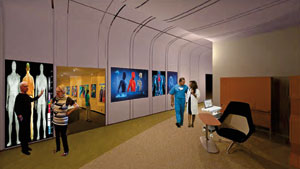
A Tangle of Memories
Although it strikes one in six Americans in their 60s—and one of every two in their 80s—fundamental aspects of Alzheimer’s disease remain unknown and in need of new avenues of research, says UTSA College of Sciences Dean George Perry.
A nationally recognized expert on the disease, which produces profound changes in the brain and is characterized by the loss of cognitive function, Perry refers to the complex, debilitating disorder as “the disease of our time.”
Great strides have been made over the past 30 years in understanding how the illness can rob otherwise healthy individuals of their mind and memory, he noted. But there is still much work to do.
Having spent decades studying Alzheimer’s, Perry hopes to add to the body of knowledge after being named to the newly created Patricia and Tom Semmes Endowed Chair in Neurobiology. The $1 million is made possible by a Semmes Foundation gift of $500,000, matched by the H-E-B Faculty Research Excellence Fund.
Such luminaries as Winston Churchill, Ralph Waldo Emerson, Henry Ford, Norman Rockwell, Rita Hayward and James Doohan, best known as Scotty on television’s Star Trek, have fallen victim to the illness, for which there is no known cure.
More recently, Pat Summitt, the University of Tennessee’s legendary women’s basketball coach who chalked up the most wins in any sport in collegiate history, stepped down after being diagnosed with it. As recently as last year, more than 1,000 clinical trials were launched to evaluate treatments, but it is not known if any of them are effective.
Current treatment focuses on the disease’s symptoms, but nothing has yet been found that reverses its progression, which can sometimes be rapid. A common symptom, dementia, causes a person to lose his or her ability to think, recall and reason to such a severe extent that it interferes with daily function.
While it was once thought to be typically age-related, studies have shown that Alzheimer’s is not a normal part of the aging process.
The theory is that over time, organisms age due to the damage done by free radicals, molecules with unpaired electrons in their shells, which leads to DNA mutations that are thought to speed up the aging process.
Cells damaged by free radicals have been associated not only with Alzheimer’s, but with other illnesses such as diabetes.
The Semmes endowment will help Perry—who is considered one of the top scientific investigators in the world in the area of free radicals—focus research efforts on the brain cells’ response to free radicals and the damage they cause.
Perry said he hopes that this research will provide an unprecedented opportunity for worldwide collaboration as well as stimulate and expand research into the debilitating affliction. The endowment will also support the coordination of research efforts at UTSA into more than 20 nervous system disorders, some of which are commonly associated with the dementia brought on by Alzheimer’s, Perry said.
“George is one of the top 10 authorities on Alzheimer’s in the world,” said Provost John Frederick. “To have such an authority in our midst will provide a place where other experts in that and other areas will want to come and collaborate.”
Perry, the editor in chief of the Journal of Alzheimer’s Disease, one of the leading research periodicals in the field, has published more than 900 studies on various aspects of the disease.
He noted that because the illness is so widespread, just about everyone knows someone who suffers from Alzheimer’s.
Over the last several decades, what was once considered almost exclusively an “old person’s” illness has been increasingly diagnosed in otherwise healthy individuals in their late 30s and early 40s.
While more than five million Americans have been diagnosed with various stages of Alzheimer’s, whether early- onset or advanced, projections are that millions more will be affected as the baby boomer generation ages.
Early-onset Alzheimer’s, the less-common form of the disease, can present symptoms early, but the person affected tends to worsen more rapidly. The most common form is late-onset, occurring in people in their mid-60s.
Studies have shown that once a person reaches age 65, the risk for getting Alzheimer’s doubles, and the risk factor continues doubling every five years after that.
“The risk just doesn’t stop, it increases as the person gets older, so that by the time people reach age 85, one of two people will have been diagnosed with some form of Alzheimer’s,” Perry said.
Some of the most feared components of the disease are the mood changes, depression and confusion triggered by the onset of dementia, which impacts just about every aspect of the affected person’s life.
Over the long term, Perry suspects that Alzheimer’s will have a higher impact in Third World countries, especially in Latin America, because those nations have significantly higher birth rates than European and Far Eastern nations.
As people in those developing countries approach their older years, the incidence of Alzheimer’s diagnoses is most likely to increase, Perry pointed out.
“The greater the number of people who live longer, the greater the problem of dealing with Alzheimer’s patients and the greater the impact will be on the society that has to deal with a larger population which is aging and which is most susceptible” to being diagnosed with it, he said.
He notes that one facet of the disease that carries particular implications for South Texans—and which he hopes to explore further—relates to its apparent connection to other illnesses like Type 2 diabetes.
“There appears to be little doubt that the diet and lifestyle habits of Hispanics make them more susceptible to Type 2 diabetes,” Perry said. “Consequently they suffer significantly higher rates of Alzheimer’s than their Anglo counterparts.”
He cited study results that noted that Hispanics over age 65 were diagnosed with Alzheimer’s at a rate of 60 percent, in contrast to the 30 percent rate for Anglos. Other studies indicate that African Americans are also diagnosed at higher rates than Anglos.
Nancy Rheams, support assistant with the Alzheimer’s Association San Antonio & South Texas Chapter, said its region of 44 counties sees a high prevalence of Type 2 diabetes among its large Hispanic population.
Because of that, she thinks Perry’s expanded research will have significant implications for her chapter.
“Whatever the kind of…research Dr. Perry might be able to launch, to find answers to common problems of Alzheimer’s could really make a difference,” Rheams noted. “Locally, that kind of research could have a potentially huge impact for us.”
A “Smart” Solution
The interior design students’ semester-long assignment seemed straightforward enough: utilize the latest in computer modeling, automation and prediction technology to redesign a house for a person living with Alzheimer’s disease.
“Technology is cutting edge, and applying such innovations could do wonders to assist, and put at ease, not only the millions of people diagnosed with the debilitating, life-changing disease, but their families and caregivers as well,” said Ela Poursani, assistant professor in the UTSA Department of Architecture.
An architect with a Ph.D. in urban theory, Poursani taught the out-of-the-box, research-heavy studio class in spring 2012.
The home environment can play an important role in managing treatment for this disease, since many older adults prefer staying home rather than in a hospital or other care setting, she said.
So the students set about designing a so-called “smart home,” one that would technologically be able to meet the needs of a patient living alone.
The key design element is a “smart wall” peppered with sensors and interactive screens that could provide a direct audio and video link with doctors, clinics, hospitals and caregivers; monitor a patient’s vital signs; and alert family members or caregivers when the resident goes out the front door at unscheduled times through remote sensors in the wall, in pillows and in shoes. Often, a person with Alzheimer’s becomes disoriented, and, if unsupervised, can easily wander away from familiar, safe surroundings with sometimes-disastrous consequences.
While the wall and the rest of the technology-heavy residence remain in the design stage and have not been built or tested, “there are updates and tech innovations that today could make such a residence possible,” Poursani said.
The class was offered as awareness of the disease’s impact on society grows and as the 2012 federal allocation for Alzheimer’s research increased by 25 percent, she noted.
Alzheimer’s affects one in eight elderly Americans, and is the nation’s sixth leading cause of death, according to federal statistics.
As more members of the baby-boomer generation reach and pass the critical age of 60, the costs associated with the disease will only increase. So the challenge for the students, all graduating seniors, went beyond applying function and design principles, Poursani said.
Statistics show that more than 20 million people in the United States live with the effects of Alzheimer’s. This includes the five million who have been diagnosed with either early-onset or full-blown dementia—and the 15 million family members and unpaid caregivers “who are affected in one way or another by Alzheimer’s,” Poursani noted.
Poursani had the students undertake extensive research, not only on architectural innovations and trends, but also on aging and Alzheimer’s. They met with aging specialists as well as experts from The University of Texas Health Science Center at San Antonio, the Audie L. Murphy Memorial Veterans Hospital and other facilities. They also met and interacted with senior citizens living at the Air Force Village in San Antonio, a retirement community for military officers or their widowed spouses.

